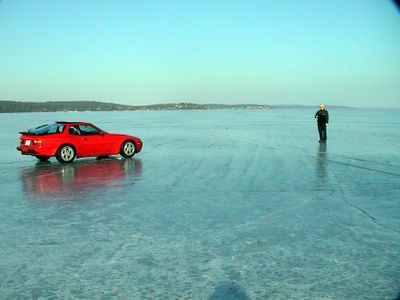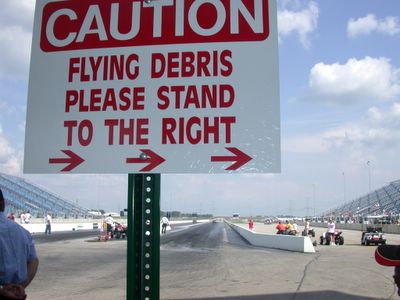Sunday Porsche Blogging – type 951 the Porsche 944 Turbo

951 on Lake Geneva
c Flying Debris
The above photo is of an old car of mine, a 1987 Porsche 944 Turbo; the Porsche factory number for that car is the 951. That shot was taken on Lake Geneva in Wisconsin, about a mile or two off of the bar Chuck’s in Fontana. The University of Chicago’s Yerkes Observatory is in the far background. A few of us had gone up to go ice boating and there wasn’t enough wind so I just had to drive around the lake in a Porsche.
That 951 was in many ways a wonderful car, although it did have a few expensive repair bills. When properly driven the car is incredibly fast, smooth and quick; for the inexperienced the turbocharged nature of the car can be dangerous. I probably would’ve kept the car for the long-term (I had it for 7 years) if I drove more. As the screen name implies I take public transportation to work everyday. Lately I’ve been putting about 3000 to 5000 total miles per year on a few vehicles. That’s what city living can do for you, not only can I walk to a grocery store and restaurants, but I can walk to Home Depot and Office Depot; the down side is that parking is ridiculous.
The Porsche 944 Turbo (951) is often on lists of relatively inexpensive but relatively exotic sports cars, excellent examples of pre-1988½ can be found well under $15,000. Even the more powerful 1988½ and later cars are now in that $15,000 range. As those magazine articles often point out, it is critical to get a well maintained vehicle. A point to pay particular attention to is the proper maintenance of the timing belts. The factory replacement schedule must be religiously followed, including follow-up adjustments. Another area to check is the motor mounts, they are made of some hard rubber-like compound and they wear out from use and age. Not only are they expensive to replace but as they wear out the engine movement endangers the torque tube, the torque tube is the drive shaft in this rear transaxle car and is not inexpensive.
The last 951 was last sold new in the US in 1990, so all of these cars are at least 16 years old and any 16 year old car will have parts that break and Porsche parts are expensive, as is service. Figure dealer shop rates at $100 per hour and private shop rates somewhere in the $60 per hour range. My advice on these and any older Porsche street car has included “be ready to spend $5000 on your car at any time, you may never have to spend it but you should always be prepared to spend it.” For an air cooled 911 a rebuild starts at about $7000. The reality of a nice $12,000 951 is that it should be seen as a $20,000 car, not only realistic but really quite a deal. It may take years to spend the extra $8000 budgeted but it will get spent.
Another great point about the 951 is that they can be dramatically improved; the bottom end of the straight-four engine is rock solid and can take much bigger forces than those it normally faces. Additionally the turbo and controlling software can easily be modified, allowing for huge power increases. Due to the car’s race history there are plenty of products to improve the power, the handling, the transmission and anything else that you could imagine, or pay for. At the 1999 24 hour race at Daytona there was a team running a 1987 street 951 that had been modified for racing. The car finished, it didn’t win anything but it finished the 24 hours. That 951 had been a well used 12 year old street car that was rebuilt and went out and took on the world’s best, not bad.
The 951 is wonderful on the highway, when Road & Track first reviewed the car they recorded the fastest highway passing times that the magazine had yet recorded. I can attest to those findings, at high speeds the car feels like it settles down (the aerodynamics give the car fantastic down force) and with proper use of the turbocharger (through throttle control and judicious gear changes) it will go from 80 to 110 in what seems like an instant. Visibility and stability of the car give the driver great confidence at high speed, the car just feels rock solid at speed. The best gas mileage that I ever got was 32 mpg., all highway driving between 60 and 80 mph.
The interior of the car is snug but comfortable and it looks fairly modern, in ’86 it was the fist car to have driver and passenger air bags as standard equipment. The ergonomics are great for me; I can reach and see all of the controls and gauges. However, I have heard complaints from others concerning their view of the gauges. The car is a hatch-back so it is very practical; I put 8’ 2x4s through the hatch and into the passenger foot well. The 951 is a 2 + 2, meaning that it has rear seats; these fold down seats would be great for kids if you could put a child’s seat into them. I didn’t try all that hard, but I never did find a seat that fit. I’m not sure if they still use the term but Porsche once referred to their rear seats as “occasional seats”, you don’t want to sit in those things, even occasionally.
Overall I would recommend the 951 as a great car as long as one accepts its limitations and costs. It is a car that I would buy again, if I was in a situation where I often found myself on highways. I would also suggest swapping the wheels for the 17” 5-spoke Carrera Cup2 wheels; they improve and update the looks dramatically. A great spot for a CD changer is under the rear carpet in the area behind the wheel well. The car also makes a great race car; after all it is directly derived from the 924 GTP that raced in the 1981 Le Mans 24 Hour race and during its production run Porsche also turned out a variety of racing versions of the 951.
Further Porsche Blogging at Flying Debris can be found here and here.


0 Comments:
Post a Comment
<< Home